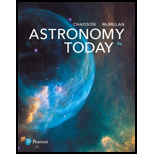
Astronomy Today (9th Edition)
9th Edition
ISBN: 9780134450278
Author: Eric Chaisson, Steve McMillan
Publisher: PEARSON
expand_more
expand_more
format_list_bulleted
Question
Chapter 1, Problem 4MC
To determine
The correct option, from the following options, for the effecton the solar dayas compared with a sidereal day, of the situation when Earth orbited the Sun in 9 months instead of 12.
(a) longer.
(b) shorter.
(c) unchanged.
Expert Solution & Answer
Want to see the full answer?
Check out a sample textbook solution
Students have asked these similar questions
A high-speed lifting mechanism supports an 881 kg object with a steel cable that is 22.0 m long and 4.00 cm^2 in cross-sectional area. Young's modulus for steel is 20.0 ⋅10^10 Pa. Determine the elongation of the cable.
Namor, from Wakanda Forever, sits on a throne at the bottom of the ocean in a city called Talocan (and Atlantis in the comics). Assuming he, including his gold headdress, has a density of 1085 kg/m3 and that Namor is surrounded by salt water with a density of 1027 kg/m3, what is Namor’s normal force while sitting underwater? Take Namor’s mass as 285. kg and solve as if he has a uniform density.
To get there they need to travel through an area of salt-water, which seems to also be a magical portal, before arriving in a dry area. Judging by the time Maui and Moana spend falling through the water, it seems they dive 3440. ft deep. Assume the portal is non-magical salt-water, with a density of 1027 kg/m^3. Given that the air pressure above the portal is 1.013 ⋅10^5 Pa, what is the pressure when they are 3440. ft deep? 1 m = 3.28 ft. Moana would have a surface area of 1.30 m2. How much force would be acting on her at the bottom of this portal?
Chapter 1 Solutions
Astronomy Today (9th Edition)
Ch. 1 - Prob. 1DCh. 1 - Prob. 2DCh. 1 - Prob. 3DCh. 1 - Prob. 4DCh. 1 - Prob. 5DCh. 1 - Prob. 6DCh. 1 - Prob. 7DCh. 1 - Prob. 8DCh. 1 - Prob. 9DCh. 1 - Prob. 10D
Ch. 1 - Prob. 11DCh. 1 - Prob. 12DCh. 1 - Prob. 13DCh. 1 - Prob. 14DCh. 1 - Prob. 15DCh. 1 - Prob. 1MCCh. 1 - Prob. 2MCCh. 1 - Prob. 3MCCh. 1 - Prob. 4MCCh. 1 - Prob. 5MCCh. 1 - Prob. 6MCCh. 1 - Prob. 7MCCh. 1 - Prob. 8MCCh. 1 - Prob. 9MCCh. 1 - Prob. 10MCCh. 1 - Prob. 1PCh. 1 - Prob. 2PCh. 1 - Prob. 3PCh. 1 - Prob. 4PCh. 1 - Prob. 5PCh. 1 - Prob. 6PCh. 1 - Prob. 7PCh. 1 - Prob. 9P
Knowledge Booster
Learn more about
Need a deep-dive on the concept behind this application? Look no further. Learn more about this topic, physics and related others by exploring similar questions and additional content below.Similar questions
- A plank 2.00 cm thick and 15.7 cm wide is firmly attached to the railing of a ship by clamps so that the rest of the board extends 2.00 m horizontally over the sea below. A man of mass 92.9 kg is forced to stand on the very end. If the end of the board drops by 5.97 cm because of the man's weight, find the shear modulus of the wood.arrow_forwardwhen considering particle B (4,1) distances in relation to P (-4, 5), why are the y coordinates being used gto resolve the distance along the x-axis and vice-versa?arrow_forwardA 198 kg load is hung on a wire of length of 3.58 m, cross-sectional area 2.00⋅ 10-5 m2, and Young's modulus 8.00⋅10^10 Pa. What is its increase in length?arrow_forward
- I. Pushing on a File Cabinet Bob has been asked to push a heavy file cabinet down the hall to another office. It's not on rollers, so there is a lot of friction. At time t = 0 seconds, he starts pushing it from rest with increasing force until it starts to move at t = 2 seconds. He pushes the file cabinet down the hall with varying amounts of force. The velocity versus time graph of the cabinet is shown below. A. On the graphs provided below, 1. draw the net force vs. time that would produce this velocity graph; 2. draw the friction force vs. time for this motion; 3. draw the applied force (Fon Cabinet by Bob) VS. time for this motion (the first two seconds of this graph have been drawn for you). Velocity (m/s) Applied Force (N) Friction Force (N) Net Force (N) A -m B -U time (s) D time (s) time (s) time (s)arrow_forwardanswer itarrow_forwardPlease draw a sketch and a FBDarrow_forward
arrow_back_ios
SEE MORE QUESTIONS
arrow_forward_ios
Recommended textbooks for you
 AstronomyPhysicsISBN:9781938168284Author:Andrew Fraknoi; David Morrison; Sidney C. WolffPublisher:OpenStax
AstronomyPhysicsISBN:9781938168284Author:Andrew Fraknoi; David Morrison; Sidney C. WolffPublisher:OpenStax An Introduction to Physical SciencePhysicsISBN:9781305079137Author:James Shipman, Jerry D. Wilson, Charles A. Higgins, Omar TorresPublisher:Cengage Learning
An Introduction to Physical SciencePhysicsISBN:9781305079137Author:James Shipman, Jerry D. Wilson, Charles A. Higgins, Omar TorresPublisher:Cengage Learning Stars and GalaxiesPhysicsISBN:9781305120785Author:Michael A. Seeds, Dana BackmanPublisher:Cengage Learning
Stars and GalaxiesPhysicsISBN:9781305120785Author:Michael A. Seeds, Dana BackmanPublisher:Cengage Learning Foundations of Astronomy (MindTap Course List)PhysicsISBN:9781337399920Author:Michael A. Seeds, Dana BackmanPublisher:Cengage Learning
Foundations of Astronomy (MindTap Course List)PhysicsISBN:9781337399920Author:Michael A. Seeds, Dana BackmanPublisher:Cengage Learning Stars and Galaxies (MindTap Course List)PhysicsISBN:9781337399944Author:Michael A. SeedsPublisher:Cengage Learning
Stars and Galaxies (MindTap Course List)PhysicsISBN:9781337399944Author:Michael A. SeedsPublisher:Cengage Learning

Astronomy
Physics
ISBN:9781938168284
Author:Andrew Fraknoi; David Morrison; Sidney C. Wolff
Publisher:OpenStax

An Introduction to Physical Science
Physics
ISBN:9781305079137
Author:James Shipman, Jerry D. Wilson, Charles A. Higgins, Omar Torres
Publisher:Cengage Learning

Stars and Galaxies
Physics
ISBN:9781305120785
Author:Michael A. Seeds, Dana Backman
Publisher:Cengage Learning

Foundations of Astronomy (MindTap Course List)
Physics
ISBN:9781337399920
Author:Michael A. Seeds, Dana Backman
Publisher:Cengage Learning

Stars and Galaxies (MindTap Course List)
Physics
ISBN:9781337399944
Author:Michael A. Seeds
Publisher:Cengage Learning

Time Dilation - Einstein's Theory Of Relativity Explained!; Author: Science ABC;https://www.youtube.com/watch?v=yuD34tEpRFw;License: Standard YouTube License, CC-BY